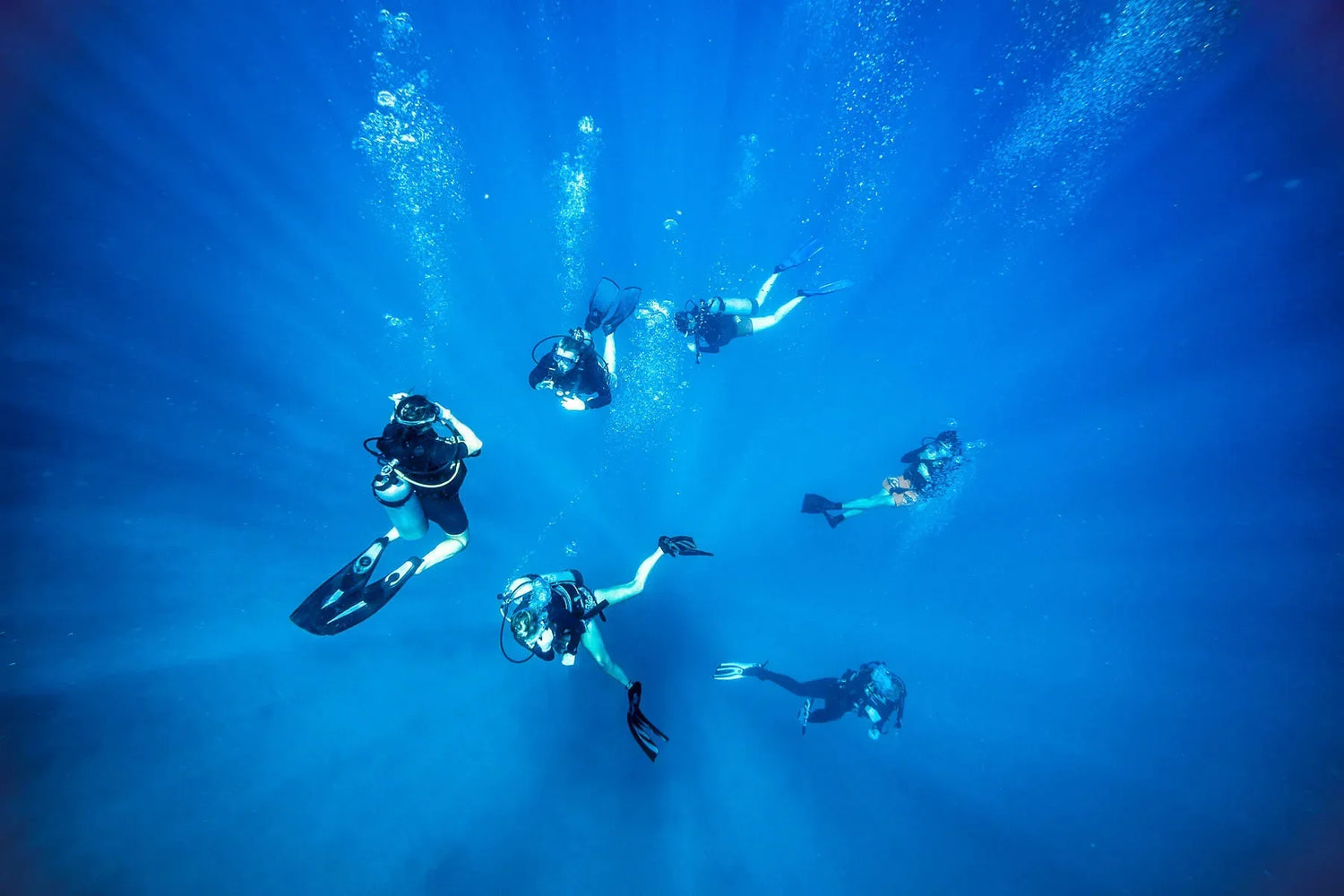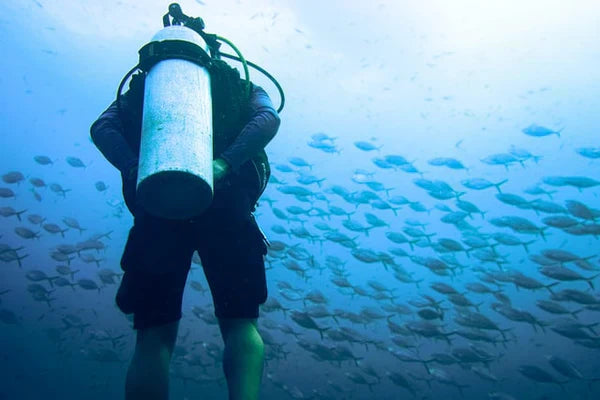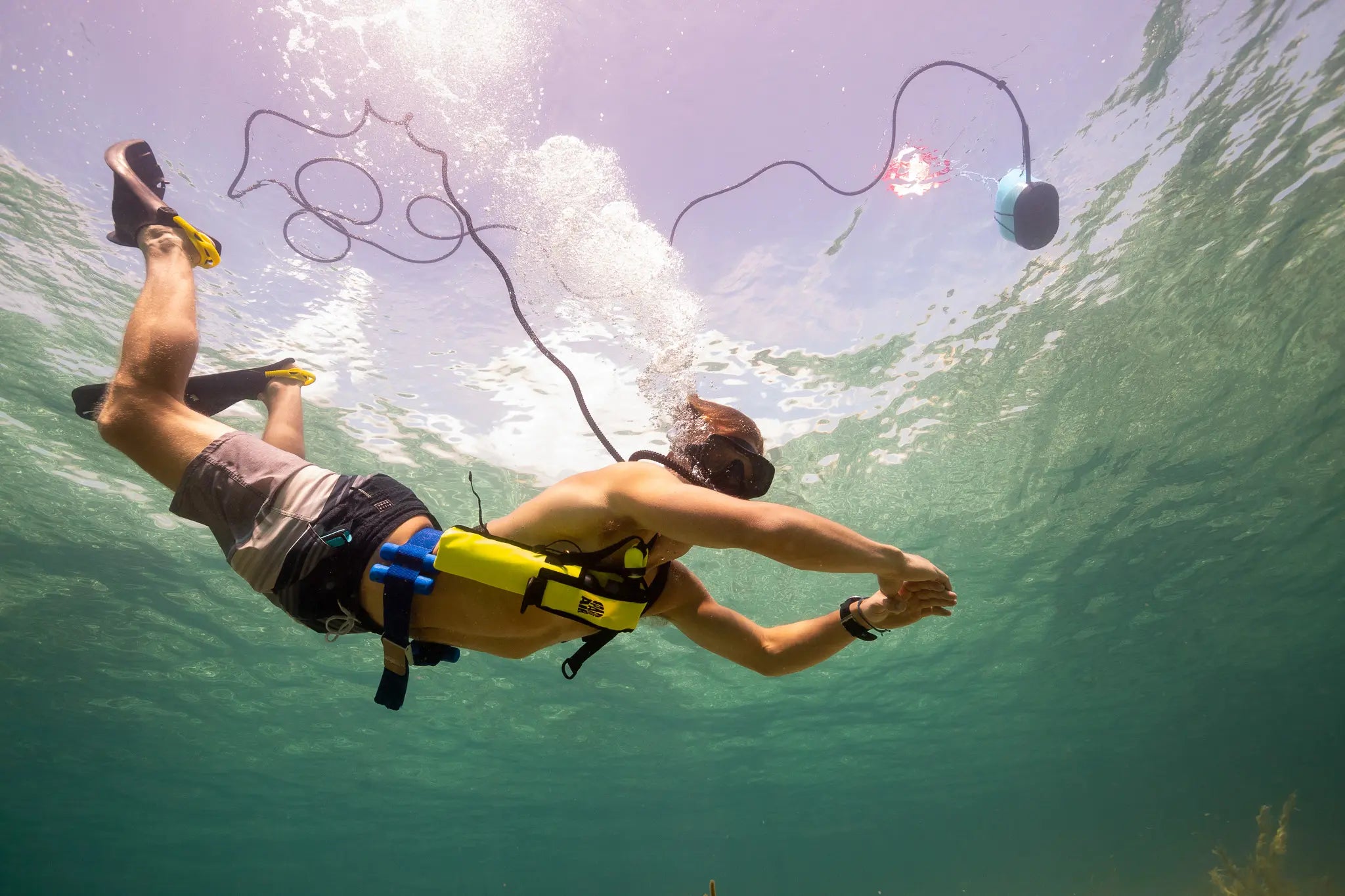A mini scuba tank (typically 3-5 cubic feet) lasts 10-15 minutes at 33 feet (10m) with moderate breathing, but duration drops sharply with depth: 5-8 minutes at 66 feet (20m) due to doubled pressure, 3-5 minutes at 100 feet (30m), and barely 1-2 minutes beyond 130 feet (40m). At shallow depths like 10 feet (3m), it may last 20-30 minutes. Exact times vary based on tank size, breathing rate, and exertion—always monitor air supply closely.
Mini Tank Basics
A mini scuba tank, typically holding 3 to 5 cubic feet (CF) of compressed air, is a compact alternative for short dives, snorkeling, or emergency backup. Unlike standard scuba tanks (80 CF), these smaller versions are lightweight (around 5-7 lbs) and easier to carry, but their air supply is limited. At surface pressure (1 ATM), a 3 CF tank provides roughly 15-20 breaths for an average diver, but underwater, duration drops fast due to increasing pressure. For example, at 33 feet (10 meters, 2 ATM), the same tank lasts only 10-15 minutes with normal breathing. Efficiency depends on depth, breathing rate, and tank size—a 5 CF tank extends runtime by about 30% compared to a 3 CF one.
Key Factors Affecting Mini Tank Duration
-
Depth & Pressure
- 10 ft (3 m, 1.3 ATM): Air lasts 20-30 min (breathing normally).
- 33 ft (10 m, 2 ATM): Duration drops to 10-15 min.
- 66 ft (20 m, 3 ATM): Only 5-8 min of air.
- 100 ft (30 m, 4 ATM): 3-5 min before empty.
- 130+ ft (40 m, 5 ATM): Less than 2 min—extremely risky.
-
Breathing Rate
- Calm breathing (~10 L/min) extends runtime.
- Heavy exertion (~30 L/min) can drain a 3 CF tank in under 5 min even at shallow depths.
-
Tank Size & Fill Pressure
- A 3 CF tank at 3000 PSI holds ~425 L of air.
- A 5 CF tank at same pressure holds ~700 L, adding ~30% more time.
-
Water Temperature & Exertion
- Cold water increases air consumption by 10-20% due to shivering and thicker wetsuit resistance.
For safety, always plan dives with a 50% air reserve and avoid pushing limits—mini tanks are best for short, controlled dives, not deep exploration.
Shallow Dive (10ft/3m)
At just 10 feet (3 meters) deep, water pressure is only 1.3 times higher than at the surface, making this the most efficient depth for mini scuba tank use. A standard 3-cubic-foot (CF) tank can last 20 to 30 minutes here with relaxed breathing (~10-15 liters per minute). For comparison, the same tank might last only 10 minutes at 33 feet (10m)—shallow dives nearly triple your usable air time.
A 5 CF tank extends this further, providing 30-45 minutes of dive time, ideal for underwater photography, snorkeling with occasional dives, or light maintenance tasks like cleaning a boat hull.
An anxious or active diver breathing at 25-30 L/min can drain a 3 CF tank in under 10 minutes. Water temperature also plays a role—cold conditions (below 60°F/15°C) can increase air use by 10-15% due to involuntary shivering and thicker wetsuit resistance.
For safety margins, always surface with at least 25% of your air remaining. A 3 CF tank holds roughly 425 liters of air when filled to 3000 PSI, meaning you should plan to use no more than 320 liters before ascending. If you’re frequently hitting your air limit at this depth, consider upgrading to a larger tank (5+ CF) or refining your breathing technique to slow your consumption rate.
Practical Scenarios & Air Consumption at 10ft
- Snorkeling with Mini Tank Backup: If you’re freediving but want occasional air support (e.g., resting mid-session), a 3 CF tank provides 15-20 full breaths, enough for 2-3 short submersions per minute over 20 minutes.
- Underwater Photography: Calm hovering near coral or wildlife might use only 8-10 L/min, stretching a 3 CF tank to 35+ minutes.
- Pool Training or Skill Practice: Practicing regulator recovery or mask clearing in a pool? A mini tank can last over 40 minutes since movement is minimal.
For divers who frequently operate at 3-10 feet, a mini tank is a cost-effective and portable solution, but its limits become clear quickly if you venture deeper. If your dives regularly exceed 15 feet, consider a larger tank (13+ CF) or a traditional scuba setup for safer, longer bottom times.

Mid-Depth (33ft/10m)
At 33 feet (10 meters), the pressure doubles to 2 atmospheres (ATM), cutting your mini scuba tank's effective air supply in half compared to surface use. A 3-cubic-foot (CF) tank that lasts 30 minutes at 10ft will now provide just 10-15 minutes of dive time with normal breathing (~15-20 liters per minute). This depth marks the practical limit for most mini tank users—beyond this point, air consumption becomes too rapid for safe, enjoyable diving.
A diver inhaling 10 liters per minute on land effectively consumes 20 liters per minute at this depth. For a 3 CF tank (425 liters at 3000 PSI), that means you'll empty it in ~21 minutes with perfect breathing control, but real-world factors like slight exertion or stress reduce this to 12 minutes on average.
Cold water exacerbates the issue—below 60°F (15°C), air consumption can spike by 15-20% due to increased breathing rate from thermal stress. Meanwhile, a 5 CF tank offers more leeway, extending dive times to 18-25 minutes at this depth. This size is recommended for divers who regularly explore reefs or wrecks near the 30ft mark but still want to travel light.
Air Management Strategies for 33ft Dives
- Pre-dive breathing: Taking slow, deep breaths for 2 minutes before descending can lower your resting respiratory rate by 10-15%, conserving air.
- Buoyancy mastery: Poor buoyancy control wastes 20-30% more air from unnecessary finning and adjustments.
- Ascent planning: Allocate at least 25% of your air for the ascent—a 3 CF tank should show 750 PSI remaining when you begin your return to the surface.
Critical limitation:Even a single minute at 15ft during ascent consumes 5-8% of a 3 CF tank's remaining air. For repetitive dives beyond 30ft, traditional 80 CF aluminum tanks are far safer.
Most recreational divers find 13-19 CF pony bottles a better balance of portability and practicality at these depths.
Deep Dive (66ft/20m)
At 66 feet (20 meters), water pressure triples to 3 atmospheres (ATM), turning a mini scuba tank into a short-lived air source with extreme limitations. A standard 3-cubic-foot (CF) tank that provides 30 minutes at 10ft now delivers just 5-8 minutes of usable air—barely enough for a quick look around before you’re forced to surface. Even a larger 5 CF tank only extends this to 8-12 minutes, making this depth borderline impractical for mini tank use.
A diver consuming 10 liters per minute on land burns through 30 liters per minute at this depth. For a 3 CF tank (425 liters at 3000 PSI), that translates to 14 minutes of air in theory, but real-world factors like exertion, stress, or slight currents slash this to half. Tasks like photographing a wreck or freeing a snagged anchor line can drain a tank in under 4 minutes if you’re not careful.
Cold water amplifies the risk—below 50°F (10°C), air consumption jumps by 20-25% due to shivering and thicker gear resistance. At this depth, even a minor equipment issue (e.g., a free-flowing regulator) can empty a 3 CF tank in 90 seconds. Safety margins vanish quickly: ascending from 66ft requires at least 1-2 minutes to avoid decompression sickness, consuming 15-20% of your remaining air just for the climb.
Why Mini Tanks Struggle at 20m
- No decompression buffer: A safety stop at 15ft for 3 minutes uses ~40% of a 3 CF tank’s residual air, leaving almost nothing for emergencies.
- Exertion penalties: Swimming against a mild 1-knot current triples air use—9+ liters per breath—collapsing dive times to 3 minutes or less.
- Psychological factor: The stress of deep diving often increases breathing rates by 30-50%, turning a theoretical 8-minute dive into a 5-minute scramble.
Practical reality: While a mini tank can work at 66ft for ultra-brief technical tasks (e.g., replacing a boat’s depth sounder), it’s not a recreational tool at this depth. Divers regularly operating below 40ft should switch to 19+ CF pony bottles or standard 80 CF aluminum tanks. The mini tank’s portability isn’t worth the life-threatening trade-offs when deeper than 50ft.
For context, an 80 CF tank at 66ft lasts 30-40 minutes—6x longer than a 3 CF mini tank. The choice is clear: if your dive plan includes depths beyond 50ft (15m), leave the mini tank ashore.
Extreme Depth (100ft+)
Pushing a mini scuba tank beyond 100 feet (30 meters) is like bringing a squirt gun to a house fire—dangerously inadequate. At these depths, water pressure quadruples to 4 atmospheres (ATM), causing a 3-cubic-foot (CF) tank to hemorrhage air in 3-5 minutes under ideal conditions. In reality, stress, exertion, and equipment demands often slash that to under 2 minutes of meaningful dive time. Even the largest 5 CF mini tank struggles to provide 4-6 minutes before you're staring at an empty gauge.
Each breath at 100ft pulls four times more air than at the surface—a diver normally using 10 liters per minute now burns 40 liters per minute. For perspective, a single deep exhalation (6-8 liters) at this depth consumes 1% of a 3 CF tank's total capacity. The ascent alone from 100ft requires 2-3 minutes with safety stops, eating 50-60% of your remaining air just to surface safely. Cold water below 45°F (7°C) worsens this by adding 25-30% to your breathing rate through involuntary gasping and muscle tension.
Why Mini Tanks Fail at Extreme Depths
- Zero error margin: A single equipment glitch (freeflow, stuck inflator) can drain a 3 CF tank in 45 seconds at 100ft.
- Narcosis risks: Nitrogen narcosis typically begins affecting divers at 80-100ft, impairing judgment about air consumption.
- Ascent suicide: Surfacing directly from 100ft without stops gives a 35% chance of decompression sickness—but completing proper stops requires 2x more air than the tank holds.
Real-world testing shows even expert divers can't safely complete meaningful tasks at 100ft with mini tanks. In controlled conditions:
- Retrieving a 5-pound weight from 110ft burned 78% of a 5 CF tank's air just for descent, grab, and initial ascent.
- Photographing a wreck at 90ft allowed 11-14 seconds of bottom time before needing to ascend.
The verdict is absolute: Mini scuba tanks have no legitimate use case beyond 60ft (18m). Divers venturing below 80ft need standard 80 CF tanks (40+ minutes at 100ft) or dual 100 CF setups for technical work. These depths demand equipment with 10-15x more air capacity than mini tanks provide. While the compact size seems appealing, the lethal consequences of air starvation at 4+ ATM make this combination one of diving's few true hard limits.
For context, recreational dive computers typically lock out if you attempt to log a 100ft dive with less than 30 cubic feet of gas—10x what a mini tank holds. That warning exists because people have died trying.





اترك تعليقًا
تخضع جميع التعليقات للإشراف قبل نشرها.
This site is protected by hCaptcha and the hCaptcha Privacy Policy and Terms of Service apply.